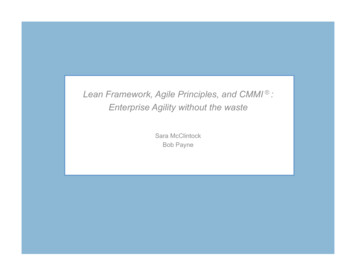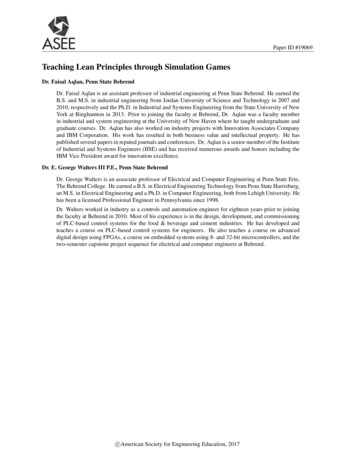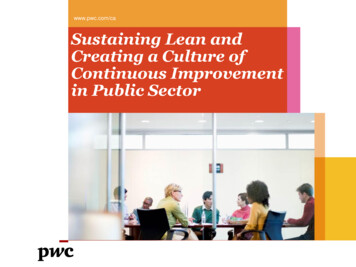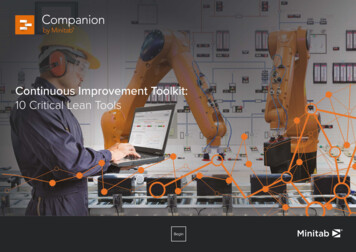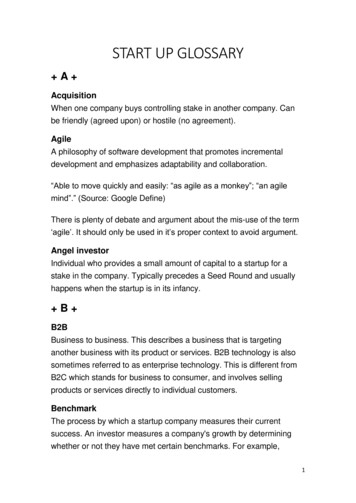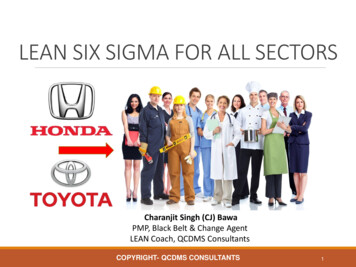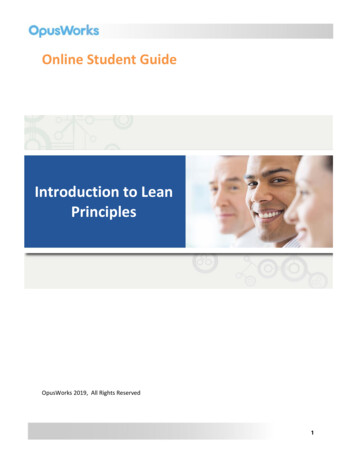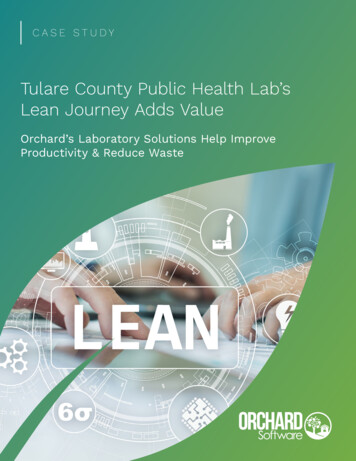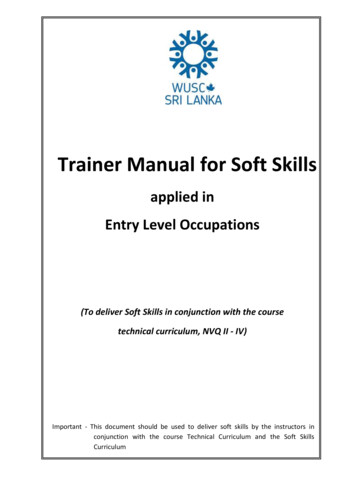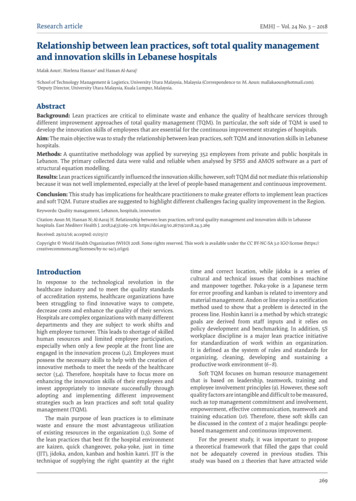
Transcription
Research articleEMHJ – Vol. 24 No. 3 – 2018Relationship between lean practices, soft total quality managementand innovation skills in Lebanese hospitalsMalak Aoun1, Norlena Hasnan2 and Hassan Al-Aaraj1School of Technology Management & Logistics, University Utara Malaysia, Malaysia (Correspondence to: M. Aoun: mallakaoun@hotmail.com).Deputy Director, University Utara Malaysia, Kuala Lumpur, Malaysia.12AbstractBackground: Lean practices are critical to eliminate waste and enhance the quality of healthcare services throughdifferent improvement approaches of total quality management (TQM). In particular, the soft side of TQM is used todevelop the innovation skills of employees that are essential for the continuous improvement strategies of hospitals.Aim: The main objective was to study the relationship between lean practices, soft TQM and innovation skills in Lebanesehospitals.Methods: A quantitative methodology was applied by surveying 352 employees from private and public hospitals inLebanon. The primary collected data were valid and reliable when analysed by SPSS and AMOS software as a part ofstructural equation modelling.Results: Lean practices significantly influenced the innovation skills; however, soft TQM did not mediate this relationshipbecause it was not well implemented, especially at the level of people-based management and continuous improvement.Conclusion: This study has implications for healthcare practitioners to make greater efforts to implement lean practicesand soft TQM. Future studies are suggested to highlight different challenges facing quality improvement in the Region.Keywords: Quality managament, Lebanon, hospitals, innovationCitation: Aoun M; Hasnan N; Al-Aaraj H. Relationship between lean practices, soft total quality management and innovation skills in Lebanesehospitals. East Mediterr Health J. 2018;24(3):269–276. https://doi.org/10.26719/2018.24.3.269Received: 29/02/16; accepted: 01/03/17Copyright World Health Organization (WHO) 2018. Some rights reserved. This work is available under the CC BY-NC-SA 3.0 IGO license /igo).IntroductionIn response to the technological revolution in thehealthcare industry and to meet the quality standardsof accreditation systems, healthcare organizations havebeen struggling to find innovative ways to compete,decrease costs and enhance the quality of their services.Hospitals are complex organizations with many differentdepartments and they are subject to work shifts andhigh employee turnover. This leads to shortage of skilledhuman resources and limited employee participation,especially when only a few people at the front line areengaged in the innovation process (1,2). Employees mustpossess the necessary skills to help with the creation ofinnovative methods to meet the needs of the healthcaresector (3,4). Therefore, hospitals have to focus more onenhancing the innovation skills of their employees andinvest appropriately to innovate successfully throughadopting and implementing different improvementstrategies such as lean practices and soft total qualitymanagement (TQM).The main purpose of lean practices is to eliminatewaste and ensure the most advantageous utilizationof existing resources in the organization (1,5). Some ofthe lean practices that best fit the hospital environmentare kaizen, quick changeover, poka-yoke, just in time(JIT), jidoka, andon, kanban and hoshin kanri. JIT is thetechnique of supplying the right quantity at the righttime and correct location, while jidoka is a series ofcultural and technical issues that combines machineand manpower together. Poka-yoke is a Japanese termfor error proofing and kanban is related to inventory andmaterial management. Andon or line stop is a notificationmethod used to show that a problem is detected in theprocess line. Hoshin kanri is a method by which strategicgoals are derived from staff inputs and it relies onpolicy development and benchmarking. In addition, 5Sworkplace discipline is a major lean practice initiativefor standardization of work within an organization.It is defined as the system of rules and standards fororganizing, cleaning, developing and sustaining aproductive work environment (6–8).Soft TQM focuses on human resource managementthat is based on leadership, teamwork, training andemployee involvement principles (9). However, these softquality factors are intangible and difficult to be measured,such as top management commitment and involvement,empowerment, effective communication, teamwork andtraining education (10). Therefore, these soft skills canbe discussed in the context of 2 major headings: peoplebased management and continuous improvement.For the present study, it was important to proposea theoretical framework that filled the gaps that couldnot be adequately covered in previous studies. Thisstudy was based on 2 theories that have attracted wide269
Research articleEMHJ – Vol. 24 No. 3 – 2018academic and managerial attention in recent years:the theory of constraints and the resource-based viewtheory. The former has been defined as “a thinkingprocess that enables people to invent simple solutions toseemingly complex problems” (11). The latter emphasizesthe significant role of resources, especially human, inthe improvement strategies at any organization. Thetheoretical framework of the study is presented inFigure 1.MethodsResearch objectivesThe foremost objective of this study was to determinethe mediating effect of soft TQM on the relationshipbetween lean practices and innovation skills ofemployees in hospitals in Lebanon. The concept ofthis study was developed upon detecting a gap in theliterature regarding the enhancement of innovationskills of employees in the healthcare sector. It seemsto be difficult for employees integrated in an ordinaryculture of standards to innovate in solving problems andreducing waste in the workplace, especially when thereis lack of staff empowerment and teamwork. Therefore,the aim of this research was to determine the ability ofemployees to enhance their innovation skills through theimplementation of lean practices as an effective meansfor elimination of waste, while maintaining a culture ofquality through practicing soft TQM.Ten hypotheses were developed based on theproposed theoretical research framework: (1) leanpractices positively and significantly affect innovationskills; (2) lean strategies positively and significantlyaffect innovation skills; (3) standardization positivelyand significantly affects innovation skills; (4) soft TQMpositively and significantly affects innovation skills;(5) lean practices positively and significantly affect softTQM; (6) lean strategies positively and significantly affectsoft TQM; (7) standardization positively and significantlyaffects soft TQM; (8) soft TQM has a significant andpositive mediating influence between lean practicesand innovation skills; (9) soft TQM has a positive andsignificant mediating influence between lean strategiesSoft TQM People-based management Continuous improvementLean practices Lean strategies Standardization (5S)Innovation skills Interpersonal,cognitive andpractical skillsFigure 1 Research theoretical framework. TQM total qualitymanagement.270and innovation skills; and (10) soft TQM has a positive andsignificant mediating influence between standardizationand innovation skills.Study designThis was a quantitative and cross-sectional study. Thesample included 162 hospitals with contracts with theLebanese Ministry of Public Health. The target populationwas hospital employees, who were estimated to number25 571 (12). The unit of analysis used was the individual,including nursing, medical, administrative and technicalstaff of hospitals. The sample size was 400 (13,14).Data collectionThe survey was conducted using a self-administeredquestionnaire. The measurement items were retrievedfrom the literature review and the content validity wasapproved through pretesting. A multistage samplingtechnique was used. First, clusters of hospitals werechosen based on distribution by type, province and levelof accreditation. Then, each hospital allowed us to surveya specific number of employees based on their ownpolicies. Finally, 400 questionnaires were distributedrandomly among the number of employees that wasrecommended by the administration of each hospital. The6-point Likert rating scale was adopted (15) to measurethe research variables. Thus, the respondents’ answersranged between 1, strongly disagree to 6, strongly agree.The survey was limited to 11 private and 2 public hospitals.Most of the surveyed hospitals had a high accreditationlevel that was appropriate for conducting the survey andachieving the research objectives.Statistical analysisSurvey data were analysed by SPSS and AMOS software.Data were screened for missing values and outlierswere checked through a simple linear regression testbased on comparing the Mahalanobis output with theχ2 test (16,17). In addition, the assumptions of linearityand homoscedasticity were approved using the normalP–P and scatter plots of the standardized residuals.Assumptions of normality were also approved throughtransformation of items using z scores. Goodness ofmeasure was achieved through testing the reliabilityand validity of the items. Data were analysed throughstructural equation modelling (SEM). The measurementmodel was assessed by checking the constructvalidity through testing the convergent validityusing confirmatory factor analysis, and constructvalidity through discriminant validity, in addition tomeasuring the composite reliability among the set ofitems representing each construct. To test the researchhypotheses, the bias-corrected bootstrap method wasapplied as it provides unbiased estimates of mediationeffects and produces more accurate confidence intervals(18).ResultsThe usable response rate for this study was 95% and nomissing values were detected. In addition, 28 outliers
Research articleEMHJ – Vol. 24 No. 3 – 2018among the respondents were checked and assumptionsof linearity, homoscedasticity and normality were alsoapproved.The first- and second-order structural modelsobtained by SEM analysis are presented in Figures 2 and3, respectively. These models were obtained after deletingitems with low standardized factor loadings ( 0.5) andhigh modification indices. Also, as suggested by Hair etal. (17), the goodness of fit indices achieved the thresholdmeasures, including comparative fit index ( 0.90),goodness of fit index ( 0.90), adjusted goodness of fitindex ( 0.90), root mean square error of approximation( 0.08) and Tucker Lewis index ( 0.90). All the constructsshowed an acceptable level of composite reliabilitywith values ranging between 0.709 and 0.895 (Table 1),indicating a high level of consistency among the items ofeach latent construct.Two hundred and fifty-seven (67.6%) respondentswere female and 197 (51.8%) were aged 20–30 years. Foreducation level, 113 (29.7%) respondents had a BaccalaureateTechnique or Superior Technician qualification. Forwork experience, 142 (37.4%) respondents had an averageof 5–10 years. Moreover, 169 (44.5%) respondents hadworked at the surveyed hospital for 5 years and 225(59.2%) respondents were nurses.Based on the descriptive statistics of researchvariables, the average mean values of all variables rangedbetween 4.36 and 5.11, indicating that employees had ahigh level of agreement regarding the measured items ofthe study: innovation skills (INS) 4.92; lean strategies (LS)4.36; standardization (S) 4.99; people-based management(PBM) 4.93; and continuous improvement (CI) 5.11).Moreover, the results of the correlation matrix indicatedthat there was no multicollinearity between the latentvariables of this study since all the correlations weresignificant at the 0.01 level and the Pearson correlationcoefficients were 0.8.Finally, the hypotheses testing results showed that6 hypotheses were accepted with significant P values at0.001 and 0.05 levels, while 4 hypotheses were rejectedwith nonsignificant P values (Table 2).DiscussionWe showed that lean practices, including lean strategiesand standardization, had a significant and positiveinfluence on the innovation skills of the employees.These results are in line with previous studies (19,20).In contrast to the traditional perception that states thatstandardization limits innovation, this study proved theopposite, as also illustrated by Kovachevam (21). He foundthat standards promote innovation when the openness ofthe standardization process is considered.For goodness of measure and based on the reliabilitytest, all the items showed a good level of internalconsistency with Cronbach’s α 0.7 (0.748 α 0.909).Exploratory factor analysis confirmed the significanceof the validity where Kaiser–Meyer–Olkin measure ofsampling adequacy values of all three constructs were 0.5 and Bartlett’s test of sphericity was significant with P 0.05 (16).The application of lean practices has been criticizedfor its lack of human integration or limited applicability.47.62e10e11TPBM2 .76 .79TPBM3 .56 .87e12TPBM4e34e35.56PBM.75.75e36CI.11 1.04.69.631.07.58STQM.89e28e27TLS5 .48.70TLS6.09.11.94LS.27 .15e37INS.72 .79 .84 S.82 .60.71.68.36.52.62TS1TS3 TS4 TS5 TS6e33e32e31e30e29e2e3.75 TCI5 .56.67 TCI4 .45e4TCI3e6e5.29.55.54.59.61.51TCI7 .40TCI6 .34Fit valuesχ2 224.157Ratio 1.546P 0 .000df 145GFI 0.940AGFI 0.921TLI 0.965CFI 0.970REMSA 0.039TINS11.34e23TINS7.52.72.61 TINS6.37e24TINS4e26e25Figure 2 First-order structural model.AGFI Adjusted Goodness of Fit Index; CFI Comparative Fit Index; GFI Goodness of Fit Index; RMSEA root mean square error of approximation;TLI Tucker Lewis Index; STQM soft total quality management; INS innovation skills; S standardization; CI continuous improvement; LS lean strategies; PBM people-based management; Transformed Items Using Z-Scores (TLS, TPBM, TS, TCI, TINS and TS)271
Research articleEMHJ – Vol. 24 No. 3 – 56e36PBM.75e28e27e31.52TS1 .62 .72 e35.83.69.71 LPCI.15 8TCI7 .40e2TCI6 .34e3TCI5 .56.75.67 TCI4 .45e4TCI3e6e19Fit valuesχ2 227.823Ratio 1.550P 0.000df 147GFI 0.938AGFI 0.920TLI 0.965CFI 0.970RMSEA 0.040.02e37.29.72 .53.59INS.84e5TINS11.34e23TINS7.52.72.61 TINS6.37e24TINS4e26e25Figure 3 Second-order structural model.AGFI Adjusted Goodness of Fit Index; CFI Comparative Fit Index; GFI Goodness of Fit Index; RMSEA root mean square error of approximation;TLI Tucker Lewis Index; STQM soft total quality management; INS innovation skills; S standardization; CI continuous improvement; LS lean strategies; PBM people-based management; Transformed Items Using Z-Scores (TLS, TPBM, TS, TCI, TINS and TS).Table 1 Average variance extracted and composite reliability of constructsConstructsItemsLL2VEAVEAVE SQRTACRInnovation 70.871STQMLean TS60.60.360.64A Cronbach’s α; AVE; Average variance extracted; AVE SQRT square root of every AVE value; CR composite reliability; L loading; STQM soft total quality management; TCI transformed items for continuous improvement; TINS transformed items for innovations skills; TLS transformed items for lean strategies; TPBM transformed items for people-basedmanagement; TS transformed items for S; VE variance error.in certain environments. Critics have suggested thatproblems arise when organizations try to apply leanpractice strategies to areas in which creativity and272innovation are required (22). The main criticism is atthe human level, where lean production is consideredto dehumanize and exploit the work force (23). It was
Research articleEMHJ – Vol. 24 No. 3 – 2018Table 2 All hypotheses testing resultsResearch hypothesesResultPH1Lean practices positively andsignificant affect innovation skillsAccepted**H2Lean strategies positively andsignificantly affect innovation skillsAccepted0.023*H3Standardization positively andsignificantly affects innovation skillsAccepted**H4Soft TQM positively and significantlyaffects innovation skillsRejected0.796H5Lean practices positively andsignificantly affect soft TQMAccepted**H6Lean strategies positively andsignificantly affect soft TQMRejected0.193H7Standardization positively andsignificantly affects soft TQMAccepted**H8Soft TQM has a significant andpositive mediating influence betweenlean practices and innovation skillsRejected0.812H9Soft TQM has a positive andsignificant mediating influencebetween lean strategies andinnovation skillsRejected0.200H10Soft TQM has a positive andsignificant mediating influencebetween standardization andinnovation skillsAccepted0.029**Significant at level of 0.05; **significant at level of 0.001.claimed by Hines et al. (24) that the key aspects of thiscriticism are the “lack of contingency and ability to copewith variability, the lack of consideration of humanaspects and the narrow operational focus on the shopfloor”. Similarly, Seddon et al. (25) criticized lean practiceprogrammes and standardization of work as demeaningand demoralizing, where workers have to do morerepetitive work.Hence, healthcare organizations in Lebanon are onthe right track in promoting the innovation skills oftheir employees as they are implementing the qualitystandards and lean practices such as the 5S programme.This tool helps organizations to eliminate inappropriateactions and sustain a productive work environment (7).Although lean practice principles are often associatedwith technical tools related to problem-solving methods,there is a soft side as well. Basically, this is the ability ofleadership to build a collaborative work environmentthat encourages other soft skills among employees, suchas communication skills and the ability to motivate andfoster teamwork (3). These features are consistent withsoft TQM methods that focus on training administrators,managers and supervisors to be lean practice leaders.Such improvements are achieved through implementingrapid improvement teams of employees, applying a5S programme, standardizing work and maintainingcontinuous improvement.The present study showed a significant directcorrelation between lean practices and soft TQM, butin particular, lean strategies had a weak correlationwith the dimensions of soft TQM compared to that ofstandardization. Furthermore, the results of hypothesestesting indicated that in general, lean practices had apositive and significant influence on soft TQM, butin particular, this influence was achieved throughstandardization and not through the lean strategies.This is consistent with the culture of accreditation andassessment at hospitals that forces employees to be moreconcerned and restricted to the standards and disciplineof work to maintain high quality of services. However,lean strategies are more dependent on employees’voluntary actions such as being involved in teamworkactivities or their speed in detecting problems in theworkplace and taking decisions to resolve them.Previous studies have shown similar findingsregarding the positive relationship between lean practicesand soft TQM (26–28). However, lean practices aregenerally weaker on the human behaviour side. There isstill a concept that considers lean practices as an inhibitorof improvement, especially when related to reducingcosts and setting limits, which can lead organizationsto be narrow-minded and hinder the creativity of theiremployees (28).In contrast to previous studies (7,29), we did notfind a direct impact of soft TQM on innovation skills.Although TQM practices have been considered essentialto develop the innovation skills of employees, they do notappear to be an effective tool for improving the necessaryskills in healthcare organizations. Several studies haveshown that TQM inhibits innovation in cases with poorimplementation (30,31); however, others have found thatTQM has a positive impact on innovation capabilities(28,32). However, criticism has been raised that effectiveTQM transformation is difficult because of weak changemanagement culture that is related to the employees’resistance to change and innovation (33).Our results indicate that soft TQM mediates therelationship between standardization and innovationskills. This is in line with previous studies (34) that haveshown that standardization can drive innovation and leadto transformation, especially at the level of employees’skills. However, soft TQM did not mediate the relationshipbetween lean practice strategies and the innovationskills of employees. The lack of skilled employees limitshospitals from generating and sustaining competitiveadvantages and consequently leads to failure of the leanpractice strategies. Such challenges result from limitedemployee participation and a shortage of skilled humanresources (1,2).By developing the theoretical framework andtesting the relationships among lean practices, softTQM and innovation skills, our research has madecontributions to the academic and practical fields. Ithas several implications for healthcare practitionersand management to take into consideration as a partof the improvement strategies at hospitals in Lebanon.In addition, it can serve as a theoretical background forfurther research in the field of lean practice healthcareand innovation at the hospital level.273
Research articleAlthough our research was conducted to fill in thegaps that were identified in the literature and previousempirical studies, there were still some limitations thatcould not be avoided, mainly at the methodological andgeographical levels. Despite the wide participation ofrespondents to this survey, poor cooperation from mostof the Lebanese hospitals was noted. Only 11 private and2 public hospitals participated. The majority of hospitalsrefused to participate because of their own policiesand considerations, while others were geographicallyunreachable because of the insecure situation in someregions. Therefore, future studies may have betteropportunities to extend their sample geographically andhave a mix of more private and public hospitals to achievemore reliable results. Another limitation faced whilepreparing this research was the lack of conceptual andempirical studies related to lean healthcare and soft TQMimplementation in the Lebanese context. This was alsoobserved empirically while conducting the survey wherelean healthcare was considered as a new concept for theLebanese healthcare sector and still not as widespreadas other quality improvement tools. Therefore, effortsshould be made to introduce lean healthcare principlesand study their implementation in hospitals in order touse them as a database for future studies of quality andlean practices.The research methods of this study were based ona quantitative approach through conducting a survey.Therefore, future studies should extend the research anduse both quantitative and qualitative methods, mainlycase studies, to obtain more accurate and practicalresults, especially since lean healthcare, innovation andquality are wide concepts that bear in-depth discussionand interpretation. Moreover, different SEM-specificsoftware can be used to test the research hypotheses suchas partial least squares.In conclusion, this study achieved its objectives andillustrated the effect of lean practices and soft TQM on theinnovation skills of employees in Lebanese hospitals. TheEMHJ – Vol. 24 No. 3 – 2018survey among different Lebanese hospitals using a selfadministered questionnaire resulted in valid and reliabledata that were analysed through SEM that ensured thatthe results could be generalized. Testing the researchhypotheses has theoretically and practically added tothe previous literature. Some of our findings supportprevious studies in which adoption of lean practices had asignificant influence on innovation skills. However, otherresults contrasted with previous studies in the positiverelationship between soft TQM and lean practices andinnovation skills. Our results showed that soft TQM isnot well implemented, especially at the level of peoplebased management and continuous improvement.This does not support the successful application of leanpractices because it is not able to enhance the innovationskills of hospital employees.The main focus should be always at the level of humanresources. Whatever efforts are made by management, ifthe employees are not convinced by the concept of leanpractices and they are not developing their own skills to bein line with the up-to-date quality and technological tools,any improvement strategy will not be successful. Policymakers and top management at Lebanese hospitals mustform priorities in their development strategies, especiallyat the level of employees because they are the dynamicresource for the implementation and development of anystrategy at the organization. It was clear from our surveythat employees are interested in lean practice tools andimplementing quality standards that tend to eliminatewaste and reduce the rate of errors in the workplace.Still, the lack of engagement and weak empowerment ofemployees lessened motivation towards the innovationprocess, which negatively affected the innovation skillsof employees. Therefore, further studies are suggestedto focus more on the means and approaches that woulddevelop the soft skills and enhance the implementationof lean healthcare within a culture of innovation andquality of services.Funding: None.Competing interests: None declared.Relation entre le lean management, la gestion totale de la qualité dite souple et lescapacités d’innovation dans les hôpitaux libanaisRésuméContexte : Le lean management est crucial pour éliminer le gaspillage et renforcer la qualité des services de soins de santéau moyen de différentes approches améliorées de gestion totale de la qualité. La gestion totale de la qualité dite souple estnotamment utilisée pour développer les capacités d’innovation des employés qui sont considérées comme essentiellesaux stratégies d’amélioration continue des hôpitaux.Objectif : La présente étude avait pour objectif principal d’étudier la relation entre le lean management, la gestion totalede la qualité dite souple et les capacités d’innovation dans les hôpitaux libanais.Méthodes : Une méthode quantitative a été appliquée en interrogeant 352 employés travaillant dans des hôpitaux privéset publics au Liban. Les données primaires recueillies étaient valables et fiables à l’analyse réalisée à l’aide des logicielsSPSS et AMOS dans le cadre d’une modélisation par équation structurelle.274
Research articleEMHJ – Vol. 24 No. 3 – 2018Résultats : Le lean management avait une influence considérable sur les capacités d’innovation. En revanche, la gestiontotale de la qualité dite souple n’intervenait pas dans cette relation du fait d’une mauvaise mise en œuvre, notamment auniveau de la gestion du personnel et de l’amélioration continue.Conclusion : Les résultats de cette étude doivent pousser les praticiens à déployer davantage d’efforts pour mettre enœuvre le lean management et la gestion totale de la qualité dite souple. Enfin, les futures études devraient se concentrersur les différents défis s’opposant à l’amélioration de la qualité dans la région. املبسطة وإدارة اجلودة الكاملة الناعمة ومهارات االبتكار يف املستشفيات اللبنانية ّ العالقة بني املامرسات حسن األعرج ، نورلينا حسنان ، مالك عون اخلالصة املبسطة عنرص ًا حيوي ًا للتخلص من النفايات وحتسني جودة خدمات الرعاية الصحية من خالل اعتامد ُنج حتسني خمتلفة ّ متثل املامرسات : اخللفية يستخدم اجلانب الناعم من إدارة اجلودة الكاملة يف تنمية املهارات االبتكارية للموظفني الرضورية ، وعىل وجه التحديد . إزاء إدارة اجلودة الكاملة . السرتاتيجيات التحسني املستمر للمستشفيات . وإدارة اجلودة الكاملة الناعمة ومهارات االبتكار يف لبنان ، املبسطة ّ متثّل اهلدف الرئييس من هذا البحث يف دراسة العالقة بني املامرسات : اهلدف وجاءت كل البيانات . موظف ًا يعملون يف املستشفيات اخلاصة واحلكومية اللبنانية 353 كمية بإجراء مسح لـ ّ استُخدمت منهجية : طرق البحث ) يف إطار AMOS( ) وبرجمية SPSS( األولية التي تم جتميعها صحيحة وموثوقة عندما تم حتليلها بواسطة برجمية احلزمة اإلحصائية للعلوم االجتامعية . النمذجة باملعادالت البنائية املبسطة أثرت تأثري ًا كبري ًا عىل مهارات االبتكار؛ يف حني مل تتوسط إدارة اجلودة الكاملة الناعمة هذه العالقة نظر ًا لعدم ّ : النتائج ّ تبي أن املامرسات . ال سيام عىل مستوى اإلدارة املتمحورة حول البرش والتحسني املستمر ، تنفيذها بشكل مناسب املبسطة وإدارة ّ تنطوي هذه الدراسة عىل اعتبارات للمامرسني يف جمال الرعاية الصحية من أجل بذل مزيد من اجلهود لتنفيذ املامرسات : االستنتاج . وتقرتح يف النهاية إجراء دراسات لتسليط الضوء عىل خمتلف التحديات التي تواجه حتسني اجلودة يف اإلقليم . اجلودة الكاملة الناعمة References1.Jekiel C. Lean human resources: redesigning HR processes for a culture of continuous improvement. New York: Taylor andFrancis Group, Productivity Press; 2011.2.Diab, S. Management of hospitals and healthcare centers. Amman: AL-Feker Publishers; 2009.3.Evershed G. Innovation from Lean Six Sigma – Soft Skills. TRIZ Journal accessed 27 November 2017).4.Putkonen A, Kairisto L, Penttilä T. Enhancing engineering students’ innovation skills through innovation pedagogy – Experiences in Turku University of Applied Sciences. International Conference on Engineering Education, Gliwice, Poland; 2010.5.Pettersen J. Defining lean production: some conceptual and practical issues. TQM J. 2009;21(
strategies such as lean practices and soft total quality management (TQM). The main purpose of lean practices is to eliminate waste and ensure the most advantageous utilization of existing resources in the organization (1,5). Some of the lean practices that best fit the hospital environment are kaizen, quick changeover, poka-yoke, just in time
